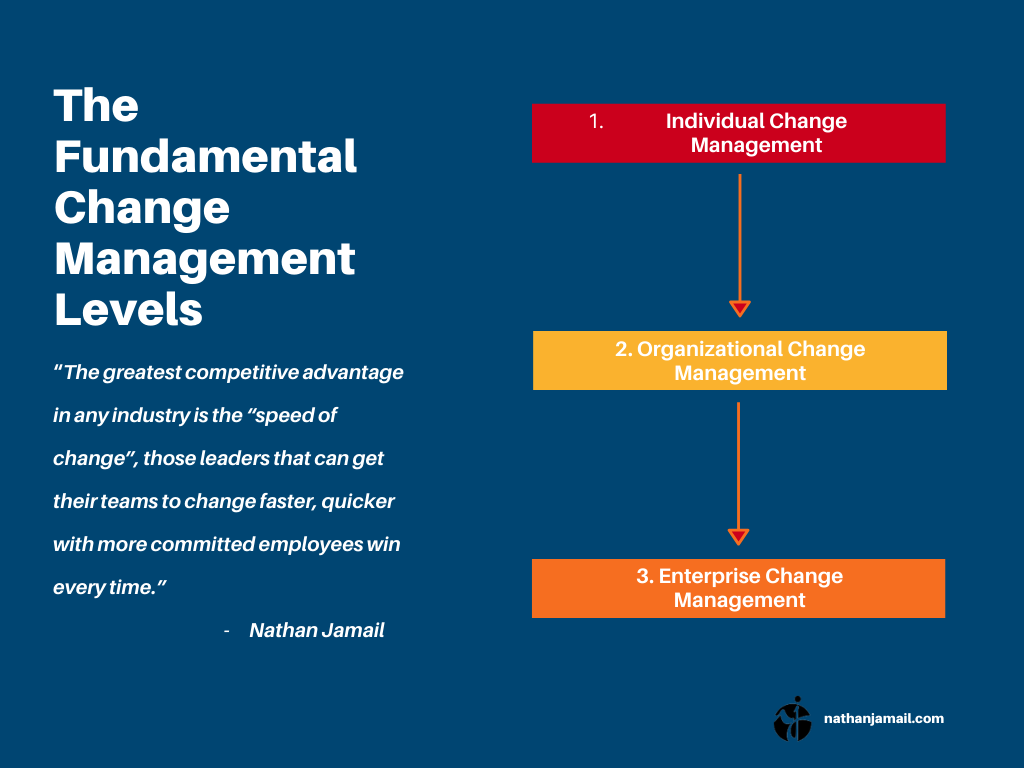“The greatest competitive advantage in any industry is the ‘speed of change’, those leaders that can get their teams to change faster, quicker with more committed employees win every time.”
Nathan Jamail
Here’s an adage we are well familiar with, ‘nothing stays the same forever’. Change is constant and, in the workplace, change is often necessary for the survival of a business. It is how leaders, like you, effectively deploy change management strategies and differentiate the failure or success of your business.
So, what exactly is this concept and how does it affect you and your employees? Well, that’s what we’ll unpack today. To start, we’ll first define change management, then, we’ll breakdown its three levels. Ultimately our objective is to help you increase the efficacy of the change process in your organization.
So…What’s Change Management?
Change management is a discipline in business strategy that, according to Prosci, prepares, supports, and helps individuals, teams and their organization, transition through organizational change.
Consequently, we can readily identify that this concept is a core competency in business change. In short it is necessary in the successful adoption of change within the workplace. What’s more, the process provides the structure that guides all stakeholders to address, adapt and cope with all transitional issues.
There are three distinct levels in the change process, they are outlined in our chart below.

The Three Levels of Change Management
-
Individual Change Management
First and foremost, the individual component is the first level that must be considered when building your change plan. The relevant question here is,
“How will we assist our individual staff members through the change transition?”
It should be noted that this is not a one size fits all profile. This level will heavily depend on one’s identity, environment, abilities, conviction, and behaviors. Therefore, leadership must remain mindful of reviewing and identifying the impact that the change will have on each employee.
-
Organizational/Project Change Management
Second, the organizational management level takes a wider look at how the change process will affect the company as a group. Here, it is important to ask,
“How will I manage the people side of change?”
People change looks beyond the scope of the technical and infrastructural changes and instead looks at the human variable. In your leadership role, the priority is to thoroughly examine the best tools to deploy across the company that will efficiently manage this transition. Essentially, the idea is to guide staff members from current state (pre-change) to a future state (successful adaption of change).
-
Enterprise Change Management
Last but certainly not least, is enterprise change management. This calls for an all-encompassing lens that ensures change is embedded in the core of your business’ structure, roles and responsibilities, processes, projects, and leadership. Your leading question will be,
“How will I build change competency throughout my enterprise?”
Moreover, you goal is a responsive enterprise that at the individual and organizational level, can be capable of actualizing quick, adaptive responses to change that limit negative productivity. Naturally this would be applicable across your company’s strategic inputs and outputs. Two examples are implementing new technology like Salesforce within your sales department or dealing with necessary strategic changes to human capital.
Over the years, we have spent a lot of time working with industry leaders to enact change in various organizations. We have observed that a company’s speediness at adapting change creates a definitive competitive advantage for businesses. A winning organization is a dynamic one, that in today’s ever changing world can allow your business to lead the pack.
Now that we’ve touched on the basics of change management, we encourage you to learn more about organization leadership and the importance of change management.






